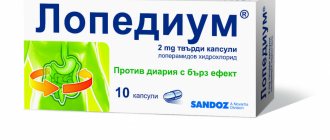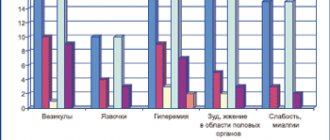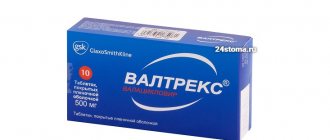Lancid®
Specific inhibitor of the proton pump (H+-K+-ATPase); metabolized in the parietal cells of the stomach to active sulfonamide derivatives, which inactivate H+-K+-ATPase. Blocks the final stage of hydrochloric acid secretion, reducing basal and stimulated secretion, regardless of the nature of the stimulus. Possessing high lipophilicity, it easily penetrates into the parietal cells of the stomach, concentrates in them and has a cytoprotective effect, increasing oxygenation of the gastric mucosa and increasing the secretion of bicarbonate.
The rate and degree of inhibition of basal and stimulated secretion of hydrochloric acid are dose-dependent: pH begins to increase 1-2 hours and 2-3 hours after taking 15 and 30 mg, respectively; inhibition of hydrochloric acid production when taken at a dose of 30 mg is 80-97%. Does not affect gastrointestinal motility. The inhibitory effect increases in the first 4 days of administration. After stopping the intake, acidity remains below 50% of the basal level for 39 hours, and there is no “rebound” increase in secretion. Secretory activity normalizes 3-4 days after stopping the drug.
In patients with Zollinger-Ellison syndrome, the effect lasts longer. Promotes the formation of specific IgA to Helicobacter pylori in the gastric mucosa, suppressing their growth, and increases the anti-Helicobacter activity of other drugs. Increases the concentration of pepsinogen in the blood serum and inhibits the production of pepsin. Inhibition of secretion is accompanied by an increase in the number of nitrosobacteria and an increase in the concentration of nitrates in gastric secretions. Effective in the treatment of gastric and duodenal ulcers resistant to histamine H2 receptor blockers. Provides faster healing of ulcerative defects in the duodenum (85% of duodenal ulcers heal after 4 weeks of treatment at a dose of 30 mg/day).
After the first dose of lansoprazole at a dose of 30 mg, the pH of the gastric juice increases after 1-2 hours. When taking the drug several times a day (30 mg), an increase in the pH of the gastric juice is noted in the first hour after administration. Duration of action is more than 24 hours. No risk of increased gastric acidity was observed after discontinuation of lansoprazole. The level of hydrochloric acid secretion is restored to normal gradually over a period of 2 to 4 days after taking several doses of the drug.
Lancid
Release forms - capsules 15, 30 mg (blisters)
Pharmacological group - proton pump inhibitor
pharmachologic effect
- proton pump inhibitor
- antiulcer
- reduces acid production
Ingredients - lansoprazole 15, 30 mg
Indications
- Gastroesophageal reflux
- Gastroesophageal reflux with esophagitis
- Gastrojejunal ulcer
- Diseases of the esophagus, stomach and duodenum
- Peptic ulcer of unspecified localization
- Esophagitis
- Other diseases of the esophagus
- Esophageal ulcer
- Duodenal ulcer
- Stomach ulcer
Composition by components
- lansoprazole
Pharmacodynamics
Lansoprazole is a selective and irreversible acid pump inhibitor. In the acidic environment of the parietal cells of the stomach (parietal glandulocytes), lansoprazole is converted into active sulfonamide derivatives, which bind to the sulfhydryl group of (H+, K+)-ATPase, an enzyme system also known as the acid (proton) pump. (H+, K+)-ATPase catalyzes the final stage of gastric acid secretion. Inhibition of (H+, K+)-ATPase by lansoprazole leads to suppression of gastric acid secretion, mediated by both central and peripheral mechanisms. The inhibitory effect of the drug is dose-dependent. Lansoprazole suppresses both basal and stimulated gastric acid secretion, regardless of the stimulus. After oral administration, lansoprazole significantly reduces the basal acid rate, and also significantly increases the average gastric pH value and the percentage of time this indicator remains at a level greater than 3-4. This drug also significantly reduces the flow rate of food-stimulated acid and the volume of secretion, as well as the flow rate of pentagastrin-stimulated acid. In addition, lansoprazole inhibits the normal increases in secretion volume, acidity and acid output induced by insulin. Lansoprazole does not have anticholinergic properties or histamine H2 receptor blocker properties.
Other actions
Due to the normal physiological effects caused by inhibition of gastric acid secretion, blood flow in the antrum, pylorus and duodenal bulb is reduced by approximately 17%; however, lansoprazole does not significantly affect blood flow in the mucous membrane of the fundus of the stomach. Gastric emptying of broken down solid food is significantly slower after taking lansoprazole. Lansoprazole increases serum pepsinogen levels and decreases pepsin activity under basal conditions and in response to stimulation of acid secretion by food or insulin injection. Like other drugs that increase intragastric pH, lansoprazole may cause an increase in the number of nitrate-reducing bacteria and increase the concentration of nitrate in gastric secretions in patients with gastric ulcers; however, to date, no significant increase in nitrosamine levels has been reported, suggesting that there is no risk of carcinogenesis associated with this mechanism. Lansoprazole and its active metabolites have been shown to have in vitro activity against Helicobacter pylori, a gram-negative bacterium, the presence of which is closely associated with peptic ulcer disease. Lansoprazole may influence the mucosal immune response to H. pylori. The formation of specific IgA to H. pylori in the mucous membrane after short-term treatment with lansoprazole is significantly enhanced, on the basis of which it is reasonable to assume that the immune system of the acid secretion apparatus is actively involved in protecting the host body from H. pylori and that the effectiveness of such a system at the level of the gastric mucosa is decisive for the complete elimination of H. pylori. Although lansoprazole itself has a relatively weak ability to kill H. pylori, it may enhance the ability of other agents to eradicate this organism: the secretagogue activity of lansoprazole may be a more important factor in explaining its effectiveness. Lansoprazole has the ability to inhibit the activity of the cytochrome P-450 enzyme system in the liver.
Pharmacokinetics
Suction. Due to the fact that lansoprazole is unstable in an acidic environment, in order to prevent its breakdown in the stomach and increase bioavailability, the drug is used in the form of capsules containing enteric-coated granules. Once lansoprazole leaves the stomach, absorption is rapid and relatively complete, with absolute bioavailability exceeding 80%. If lansoprazole is taken within 30 minutes of a meal, the bioavailability of the drug may be reduced compared to that observed when taken on an empty stomach. In case of liver cirrhosis, absorption of the drug may be slow.
Distribution. Lansoprazole penetrates into tissues, in particular into the lining cells of the stomach. The apparent volume of distribution after oral administration of a dose of 30 mg is approximately 0.5 l/kg.
Protein binding. Very high (about 97%); protein binding remains constant in the concentration range of 0.05 - 5 μg/ml. In patients with impaired renal function, protein binding may be reduced by 1 - 1.5%.
Biotransformation. Lansoprazole is metabolized in significant quantities in the liver into 2 main excreted metabolites, which are inactive. In the acidic environment of the parietal cells, lansoprazole is converted to 2 active compounds that inhibit (H+, K+)-ATPase-catalyzed gastric secretion within the parietal cell tubules, but these compounds are not present in the systemic circulation.
Half-life. Elimination phase - With normal renal function: Approximately 1.5 hours. With impaired renal function: Shortened. In elderly patients: 1.9 - 2.9 hours. In case of liver dysfunction: 3.2 - 7.2 hours.
Start of action. An increase in intragastric pH is observed 2 - 3 hours after a single dose of 15 mg, 1 - 2 hours after a single dose of 30 mg or with multiple doses of 15 mg, after 1 hour with a multiple dose regimen of 30 mg. Time to reach maximum concentration: Approximately 1 - 2 hours. When taking lansoprazole in the morning, the time to reach maximum concentration is less than when taking the drug in the evening. Maximum serum concentration: After oral administration of a single dose of lansoprazole 30 mg, the average maximum serum concentration in volunteers was in the range of 0.75 - 1.15 mg/l. Although there is essentially no correlation with lansoprazole serum concentrations, inhibition of gastric secretion appears to be dose proportional. Serum concentrations of lansoprazole after morning dosing may be 2-fold or greater compared with evening dosing schedules. When lansoprazole was administered within 30 minutes after a meal, both the maximum serum concentration and the area under the concentration-time curve were reduced by approximately 50% compared with dosing in the fasted state. The concentration of lansoprazole and its active metabolites within the parietal cells of the stomach is the main factor determining its effectiveness as a secretagogue.
Duration of action. More than 24 hours. After stopping the use of lansoprazole, the level of acid in the stomach does not increase to 50% of the basal flow earlier than after 39 hours. No rebound increase in gastric acidity was observed after stopping the use of lansoprazole. In patients with Zollinger-Ellison syndrome, the duration of action of lansoprazole is longer.
Excretion. Renal - Approximately 14 - 25% of the lansoprazole dose is excreted in the urine in the form of conjugated and unconjugated hydroxylated metabolites. Less than 1% of unchanged lansoprazole is found in urine. With bile/feces - Approximately 2/3 of the dose of lansoprazole is found as metabolites in the feces. During dialysis - Lansoprazole and its metabolites are not significantly dialyzed; hemodialysis removes an undetectable portion of the drug. Elimination of the drug is longer in healthy elderly people, in adult patients and elderly patients with mild renal impairment and in patients with severe liver diseases.
Application
Duodenal ulcer (treatment) - Lansoprazole is used for short-term (up to 4 weeks) treatment of duodenal ulcer in the acute stage in order to reduce the symptoms of the disease and scar the ulcer. Erosive esophagitis (treatment) - Lansoprazole is used for short-term (up to 8 weeks) treatment of any grade of erosive esophagitis associated with gastroesophageal reflux disease, with the goal of reducing symptoms of the disease and healing of lesions. Lansoprazole can be used for an additional 8 weeks in patients whose esophageal lesions have not healed. If erosive esophagitis recurs, an additional course of treatment with lansoprazole may be considered. Hypersecretory conditions of the stomach (treatment) - Lansoprazole is used for the long-term treatment of pathological hypersecretory conditions, including Zollinger-Ellison syndrome. Gastric ulcer (treatment) - Lansoprazole is used for short-term (up to 8 weeks) treatment of gastric ulcer in the acute stage.
Dosage regimen
Usual dose for adults: Duodenal ulcer (treatment) - Orally, 15 - 30 mg 1 time per day, preferably in the morning before meals, up to 4 weeks. Erosive esophagitis (treatment) - Orally, 30 mg 1 time per day, preferably in the morning before meals, up to 8 weeks. For patients whose esophageal defects do not heal within the first 8 weeks, an additional 8-week course of treatment may be beneficial. If erosive esophagitis recurs, a third 8-week course of treatment may be considered. Hypersecretory conditions of the stomach, including Zollinger-Ellison syndrome (treatment) - Orally, initially 60 mg 1 time per day, preferably in the morning before meals, increase the dose if necessary. Some patients received 90 mg 2 times a day for 4 years. Gastric ulcer (treatment) - Orally, 15 - 30 mg 1 time per day, preferably in the morning before breakfast, for 4 - 8 weeks. Note: Daily doses above 120 mg should be given in divided doses. In patients with severe liver dysfunction, a dose reduction should be considered; as a rule, in these patients the dose should not exceed 30 mg per day.
Typically prescribed maximum doses for adults: Peptic ulcer of the duodenum and stomach - 30 mg per day. Hypersecretory conditions of the stomach - 180 mg per day. Usual Dose for Children: Safety and effectiveness have not been determined in children under 18 years of age. Typically prescribed maximum doses for older people: 30 mg per day. It is important to take the drug before meals, preferably in the morning.



